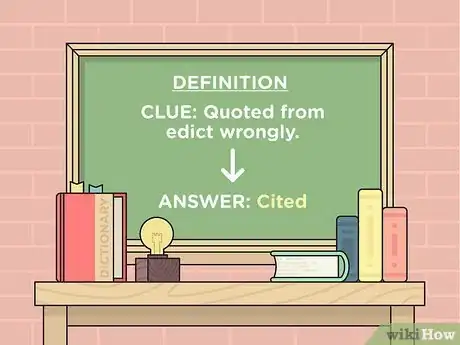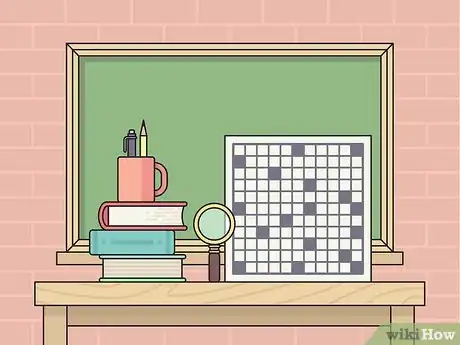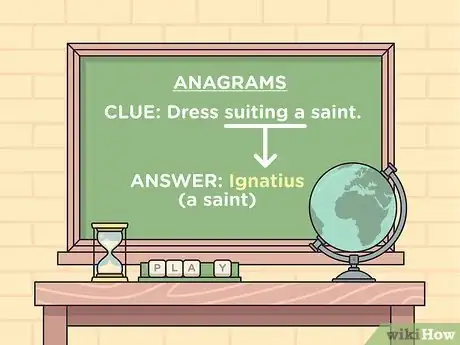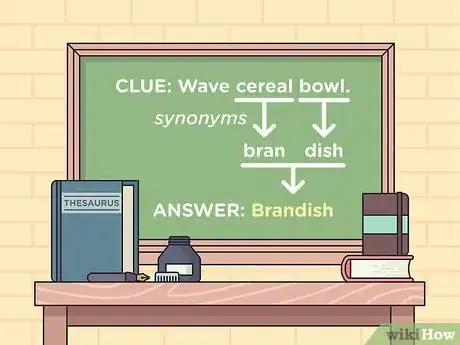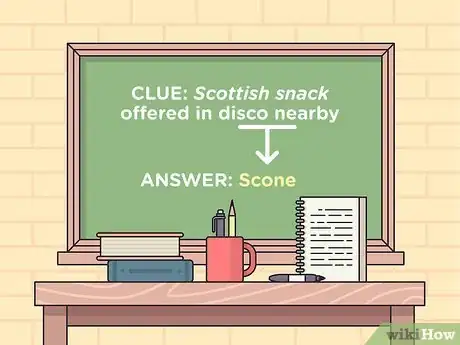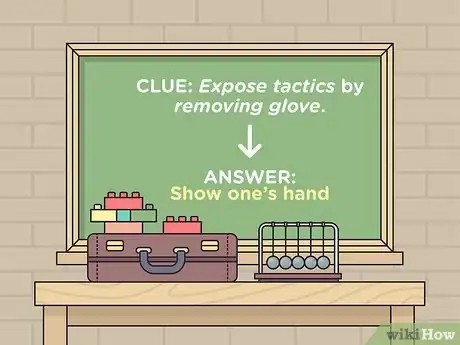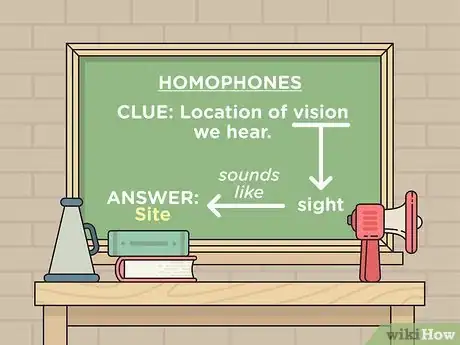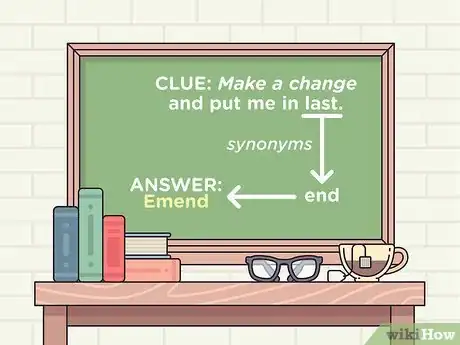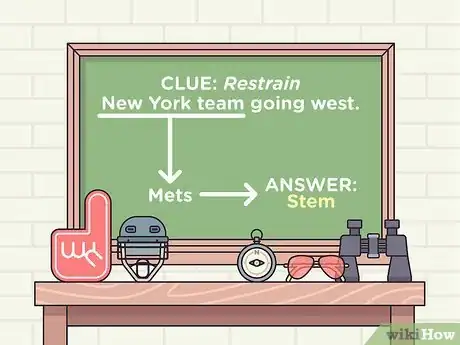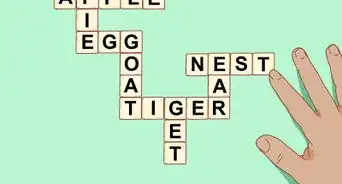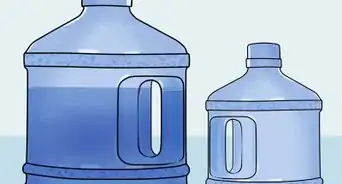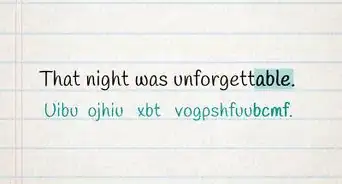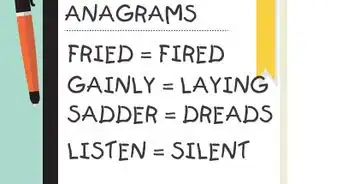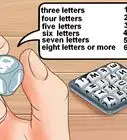This article was co-authored by wikiHow Staff. Our trained team of editors and researchers validate articles for accuracy and comprehensiveness. wikiHow's Content Management Team carefully monitors the work from our editorial staff to ensure that each article is backed by trusted research and meets our high quality standards.
There are 8 references cited in this article, which can be found at the bottom of the page.
wikiHow marks an article as reader-approved once it receives enough positive feedback. In this case, 91% of readers who voted found the article helpful, earning it our reader-approved status.
This article has been viewed 193,573 times.
Learn more...
Unlike standard or “New York Times-style” crosswords, cryptic crossword clues almost never have a literal meaning. Instead of reading such a clue to determine its answer, you must carefully decode it in order to reveal the answer. Every cryptic clue contains a definition, wordplay, and an indicator term. After you learn this formula as well as the eight most common cryptic crossword devices, you’ll be on your way to solving even the toughest of cryptic crosswords!
Steps
Identifying the Main Parts of the Clue
-
1Pick out the clue's “definition." Look near the beginning or end of the sentence to determine which word in the clue is the definition. Definitions are almost always located near the beginning or end of the sentence. The clue’s definition is very important because it tells you the literal meaning of the answer you are looking for. [1]
- Consider the following clue: “Quoted from edict wrongly.” “Quoted from” is the definition because it comes at the beginning of the sentence and hints at the clue's answer. The definition is often a synonym of the clue's answer, which is “cited” in this case.
- When the definition is less obvious, identify the two possibilities then eliminate one by considering the rest of the clue. In “Desire for Japanese money,” the definition could be “desire” or “Japanese money.” "Japanese money” is the definition and a synonym of “Yen,” which is the answer to this particular clue.
- It is impossible to solve the clue with the definition alone. However, the definition should shape your thinking. Think about synonyms or other descriptive words that relate to your definition once you have found it.
-
2Identify the clue’s “wordplay.” After identifying the definition, consider the rest of the clue to be wordplay. The clue’s wordplay is designed to be misleading, so don’t try to interpret the phrase literally. Instead, you’ll need to carefully pick through the wordplay to identify the clues, which have been hidden by the puzzle creator, to solve the clue. Cryptic crossword puzzle designers use a number of different “clue devices” or patterns when designing wordplay.[2]
- To solve the clue, you’ll need to know what device is being used in the wordplay. That's where the indicator comes into play.
Advertisement -
3Guess the “indicator term” by memorizing common indicator words. Look at the wordplay portion of the clue to locate the indicator term. This term will help you guess which wordplay device is being used. Once the indicator term has led you to the clue device, you’ll be able to apply its rules in order to solve the puzzle.[3]
- For example, within “edict wrongly,” “wrongly” is the indicator term. Once you’ve studied the common clue devices and indicator words, you’ll be able to tell right away that this clue is using an anagram!
- “Wrongly” and other words such as "broken," "confused," etc., indicate that the letters of a word need to be rearranged to reveal the answer, which is how an anagram works.
- In this case, “wrongly” refers to “edict,” so you know you’ll need to scramble the letters to reveal a new word. The new word, as we already know, is “cited” which is the answer because it is a synonym for “quoted from,” the clue definition. Voila!
- Before you are ready to start solving clues, you’ll need to memorize the common indicator terms and their corresponding clue devices!
Creating New Words from Letters Present in the Clue
-
1Rearrange the clue's letters when dealing with anagram clues. Solve an anagram by rearranging the letters of a word to reveal the hint, which, along with the definition, will help you find the clue’s answer. As with the previous clue, “edict” becomes “cited” after you shuffle the letters in the wordplay around.[4]
- Spot an anagram by looking for words that indicate change or modifications. Common anagram indicator words include “transfer,” “cook,” “dress,” “out,” “off,” “moved,” or “lost.”
- The words you will need to jumble will be located either directly before or after the indicator word.
- For example, the following clue is an anagram: “Dress suiting a saint.” “Saint” is the definition and “dress suiting a” is the wordplay. “Dress” indicates that this is an anagram because it implies change. Since there are no words preceding “dress,” you know that the words that follow it, “suiting a,” are the words that need to be rearranged. “Suiting a” can be reshuffled to reveal “Ignatius,” a saint!
- Anagrams are often the longest words in the crossword puzzle.
-
2Join parts of words together to find the answer with charade clues. Charades are formed by joining parts of words from the clue together to create a new word. Charades do not usually have indicator words, but typically contain words such as “has,” “with,” “and,” or similar conjunctions. [5]
- You’ll often need to think in terms of synonyms to know which words to join together.
- For example, in the following clue, “wave cereal bowl,” “wave” is the definition. By process of elimination, you know you are working with the words “cereal” and “bowl.” If you look for synonyms, you’ll get “bran” (for cereal) and “dish” (for bowl). Using the charades method of combining words, you’ll get “brandish,” which is the answer because it is a synonym of your definition, “wave.”
- In addition to synonyms, you may need to work with word abbreviations in order to solve charade clues. For example, “place on bottom of sack:” “Pl” is the abbreviation for “place” and “under” is a synonym for “on bottom.” Combine the two to get “plunder,” which also means “sack” (your definition).
-
3Combine letters from different words to answer clues with hidden words. Identify a hidden-words clue by recognizing indicator terms such as “some,” “buried in,” “held by,” or “in part.” Scan your sentence for words that can be made by combing the first or last letters from one word with letters from an adjacent word.[6]
- For example, in the clue “Scottish snack offered in disco nearby,” your definition is “Scottish snack,” the indicator is “offered in,” and your wordplay is “disco nearby.”
- The hidden word will always be located in your wordplay phrase, so scan it carefully and consider whether there is a word that can be made by combining parts of “disco nearby” that matches the definition “Scottish snack.” You’ll find the answer by combining the last three letters of “disco” with the first two letters of “nearby” to make “scone!”
De-Coding the Clue’s Meaning
-
1Infer the clue's second meaning to solve double definition clues. Look for linking words such as “into,” “by,” and “and" to spot double definitions. These clues typically don’t use indicator words and vary a bit from the standard clue format. Instead of having a definition, wordplay, and indicator, they have two definitions whose meaning points to the same solution.[7]
- For example, consider the clue “expose tactics by removing glove.” You know that “expose tactics” is one definition and is joined to the second definition “removing glove” with the connector “by.”
- After reflecting on the meaning of both definitions and trying to assess what they have in common, you’ll arrive at the answer: “Show one’s hand.”
-
2Decipher the clue's riddle when solving a cryptic definition clue. Examine your clue for question marks to identify a cryptic definition clue. With cryptic definition clues, the entirety of the clue is your hint—there’s no wordplay section of the clue.[8]
- In the following clue, “Hairstyle with comb in it?” you’re looking for a word that captures the entire meaning of the sentence. "Comb" is not meant literally but refers to “honeycomb.” The answer is “beehive,” which is a hairstyle and relates to the “honeycomb” reference.
-
3Look for words that sound alike to solve homophone clues. Spot a homophone clue by noticing indicator words that refer to sound, such as “heard,” “sounds like,” “say,” or “spoken." Homophones are two words that have different meanings but that sound alike when said aloud, such as “bow” and “beau.” Examine the wordplay for potential homophones, making sure to consider synonyms.[9]
- For example, in the clue “Location of vision we hear,” “location” is the definition, “we hear” is the indicator, and “vision” is the word that will produce the homophone.
- You’ll need to consider synonyms of the definition (“location”) and the wordplay target (“vision”) to produce the homophone. In this case, a synonym of “vision” is “sight,” which is a homophone of “site” (a synonym of your definition). Therefore, the clue answer is “site”!
Re-Ordering Words to Find the Answer
-
1Insert words inside of other words to solve container clues. Look for indicator words such as “within,” “around,” “in,” “inside,” and “retain” to identify a container clue. Container clues require inserting either letters or words inside of another to form a new word, which will hint at your answer. As always the words to be combined will be located in the wordplay section of your clue.[10]
- For example, in the clue “Make a change and put me in last,” “Make a change” is the definition and “put me in last” is the wordplay. “In” signifies that this is a container clue. Because inserting "me" into "last" doesn't yield any immediate results, you'll need to think in terms of synonyms and abbreviations.
- When you consider synonyms, you’ll discover that “end” is a synonym of “last” and when you insert “me” in the middle of “end” you’ll get “emend,” which means to “make a change.”
- Look out for indicator clues that also imply a sense of surrounding, such as “astride,” “clutching,” “eating,” “going around,” and “protecting.”
-
2Spell words backward when working with reversal clues. Notice whether your clue contains any indicator words such as “backfiring,” “coming back,” “going west,” “go around,” “spun,” or “recalled” to spot reversal clues. These words, which indicate direction, often signify that the answer to your clue will involve spelling a word backward, or in reverse.[11]
- Consider the following clue: “Restrain New York team going west.” Following your established procedure, you’ll first identify the definition (“restrain”), the wordplay (“New York team), and the indicator (“going west”).
- Using your powers of synonym identification, you’ll cleverly deduce that the “Mets” are a New York team and that “Mets” spelled backward gives you “stem.” “Stem” is the answer because it is also a synonym of “restrain” (your definition).
Community Q&A
-
QuestionWet duck in fog is the cryptic clue. The answer is moist. Please explain why this is the answer?
 Community AnswerDuck is 0 in cricket. He went for a duck. So mist is fog with zero in it = moist = wet.
Community AnswerDuck is 0 in cricket. He went for a duck. So mist is fog with zero in it = moist = wet. -
QuestionCan I make my own cryptic clue?
 Community AnswerYes. 1. Choose an answer first. 2. Find a synonym for the word. 3. Choose a cryptic method for the clue to be solved. 4. Find similar definitions for the words. 5. Polish the clue. 6. Look for any logical mistakes.
Community AnswerYes. 1. Choose an answer first. 2. Find a synonym for the word. 3. Choose a cryptic method for the clue to be solved. 4. Find similar definitions for the words. 5. Polish the clue. 6. Look for any logical mistakes. -
Question"Gold" metal of the mouth. This is the cryptic clue...I want to know the answer.
 Community AnswerThis is a clue for "ORAL." In French and similar languages, "OR" is the translation of "gold." "AL" is the chemical symbol for aluminum, another metal. And "oral" means "of the mouth."
Community AnswerThis is a clue for "ORAL." In French and similar languages, "OR" is the translation of "gold." "AL" is the chemical symbol for aluminum, another metal. And "oral" means "of the mouth."
References
- ↑ https://www.pennydellpuzzles.com/upload/documents/How%20to%20Solve%20Cryptic%20XWD.pdf
- ↑ http://solving-cryptics.com/
- ↑ https://www.dummies.com/games/crossword-puzzles/solving-cryptic-crosswords-for-dummies-cheat-sheet-australian-edition/
- ↑ http://solving-cryptics.com/types-of-clues/
- ↑ http://solving-cryptics.com/types-of-clues/
- ↑ https://www.dummies.com/games/crossword-puzzles/solving-cryptic-crosswords-for-dummies-cheat-sheet-australian-edition/
- ↑ https://www.pennydellpuzzles.com/upload/documents/How%20to%20Solve%20Cryptic%20XWD.pdf
- ↑ http://solving-cryptics.com/types-of-clues/
- ↑ http://solving-cryptics.com/types-of-clues/
About This Article
To solve a cryptic crossword, try to identify what type of clue you’re dealing with. For example, if you have a clue with a word indicating change, like “transfer,” “lost,” “moved,” or “cook,” it may be an anagram, in which case you need to rearrange the letters. If your clue contains a word like “has,” “with,” or “and,” it may be a charade clue, in which case you’ll join together synonyms for the words in the clue to create a new word. Keep reading to learn how to solve other types of clues, like double-definition, homophone, and cryptic definition clues.
